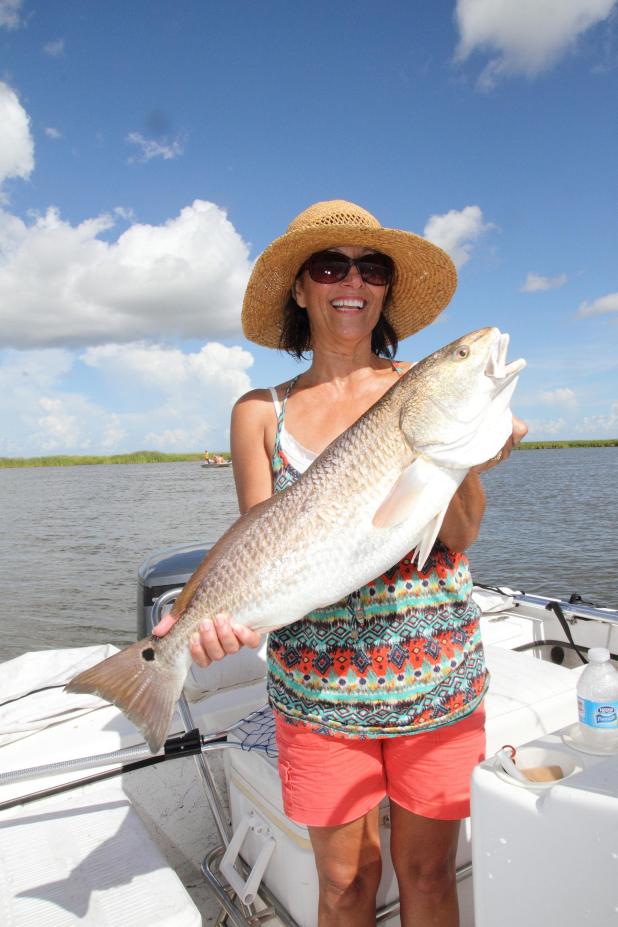
The Review/John K. Flores
The author’s wife shows a 28-inch mature redfish she caught on Marsh Island. This mature red fish is the size LDWF officials would prefer escaping the in-shore estuaries to go offshore to spawn.
John K. Flores: Redfish numbers are down; expect changes soon
During the 1980s, Cajun cuisine became all the rage across America, with much of it led by New Orleans Chef, the late Paul Prudhomme. One particular dish that Prudhomme was noted for was his blackened redfish.
Subsequently, commercial red fish (also known as red drum) landings for Florida, Louisiana and Texas reached upwards of 4 to 5 million pounds annually. It wasn’t long after when the recreational fishing political machine went into motion that commercial fishing of red drum was banned in Federal waters. What’s more, also banned in state waters by the Louisiana Department of Wildlife and Fisheries. The death knell for commercial fishing perhaps came once and for all with the banning of gill nets in 1995.
What’s interesting is an LSU AG Center Sea Grant report indicated from 1980 through 1988 that 28 percent of all red drum harvested were caught commercially. By contrast, 72 percent of red drum were taken recreationally. One must bear in mind that both commercial and recreational activities took place in the very same estuaries.
In those years prior to the 80s there were no red drum regulations. The fishery essentially went unregulated. Then, in 1977 the recreational possession limit was set at 50 red drum with no more than two allowed to be over 36 inches long.
Seven years later, in 1984, the possession limit became the daily limit with a saltwater fishing license required. And, in 1987 the recreational length was set, requiring red drum to be a minimum of 14 inches in length in order to keep.
In 1988 things radically changed. The creel limit was reduced to 5 red drum with a slot limit of 16 to 27 inches of which only one of the keepers could be over 27 inches in order to protect the fishery.
For the past 35 years, Louisiana redfish anglers have enjoyed this limit to the envy of surrounding states along the Gulf of Mexico whose regulations are more restrictive.
The problem is, red drum stocks have been declining since 2005. When red drum larvae move into the quiet bays of coastal estuaries they grow quite rapidly. A one-year-old red drum will grow on the average to be approximately 10 to 17 inches in length. A two-year-old red drum will reach an average size of 18 to 24 inches and a three-year-old will reach 20 to 28 inches.
Red drum are estuary dependent. In general, redfish anglers typically catch fish in the three-year-old range. The problem with that is once these fish reach 26 inches, they are ready to move offshore, where they can begin to spawn. According to the LDWF, 97 percent of red drum harvested are juveniles. In short, fish under 27 inches in length brings us to “escapement rate.”
Escapement rate by LDWF definition is the percentage of red drum that pass through the recreational fishery from inshore waters to offshore waters as fish that can spawn. That escapement rate is set at 30 percent by the department where currently the rate is approximately 20 percent and not enough to maintain the fishery.
Another important measurement the LDWF is watching closely is the Spawning Potential Ratio. This ratio is the number of red drum available to spawn as it relates to the population if they were not fished. Put another way, it is the percentage of red drum that pass through the fishery from inshore waters as juveniles and make it to become spawning stock offshore. The SPR is currently above the 20 percent limit set by the department, but as mentioned, has been declining.
Besides overfishing, there are a number of other factors that influence fish stocks. The LSU Ag Center says besides recreational fishing, red drum can be affected by water temperatures, sea level, cold fronts, pollution, river discharge, salinity, tide combinations, habitat loss, and even climate change.
The LDWF sent out a press release in February seeking public input by inviting saltwater anglers to take an online survey with recommended management options to reduce creel limits that will help restore red drum stocks both inshore and offshore.
Bill Lake, owner/operator of Bayou Guide Service based out of Bayou Dularge south of Houma, for the past four years has seen a decline in slot reds — those red drum in the 16-to-27-inch range.
Lake said, “I take people out 150 to 160 days a year. I have 6 boats and 6 Captains. We’re seeing so many fish 27 to 30 inches and up, it’s unbelievable. Some of the holes I go to, there’s no more 16 to 27 inch slot reds to be caught.
“Are we catching them all?” Lake continued. “I don’t think we are, but something is going on. I honestly don’t know what’s going on with them, but there’s definitely not the numbers we’re used to seeing. During Thanksgiving last year we caught 37 redfish in one hole and 31 of them were over 27 inches long.”
According to the LDWF press release the department must take action to rebuild the population to the minimum escapement level. Therefore, the department is considering several management change options to reduce harvest levels in order to allow red drum stocks to recover.
For more information on red drum status and management changes go to www.wlf.louisiana.gov/page/hot-topic-red-drum to learn more.
